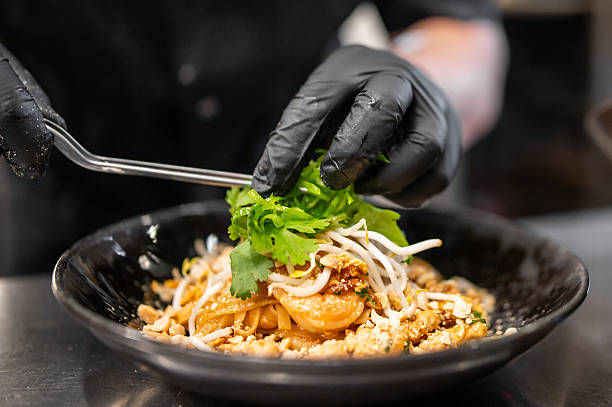Elevate Your Cooking with Pad Thai Rice Noodles: Tips and Recipes for Every Meal
Pad Thai rice noodles are a staple ingredient in Thai cuisine, renowned for their delicate texture and ability to absorb vibrant flavors. While most people associate these noodles exclusively with Pad Thai, their versatility goes far beyond that iconic dish. Whether you’re looking to recreate authentic Thai street food or experiment with innovative recipes, pad thai rice noodles provide a fantastic foundation for a wide array of meals. This article will guide you through everything you need to know from selecting the right noodles to creative ways of incorporating them into your cooking.
Understanding Pad Thai Rice Noodles: What Makes Them Unique?
Pad thai rice noodles are flat, medium-width noodles made primarily from rice flour and water. Unlike wheat-based pasta, these noodles have a subtle flavor and a unique chewiness that stands out when cooked properly. Their porous texture allows them to soak up sauces beautifully without becoming mushy, making them ideal for stir-fry dishes. Available mostly in dried form, they require soaking or brief boiling before use, which helps preserve their firmness and prevents overcooking. Their gluten-free nature has also made them a popular choice for those with dietary restrictions.
Choosing the Perfect Pad Thai Rice Noodles
Not all rice noodles are created equal, and selecting the right variety can make a significant difference in your cooking. When shopping, look for noodles labeled specifically as pad thai rice noodles or medium-width rice sticks. Thinner rice vermicelli won’t deliver the same satisfying texture, while wider noodles might be too soft for stir-frying. It’s also helpful to choose noodles with simple ingredient lists rice flour and water are usually the only components you want. Properly chosen pad thai rice noodles ensure your dish will have the perfect balance of chew and tenderness.
Preparing Pad Thai Rice Noodles for Cooking Success
Preparation is key to working with pad thai rice noodles. They should be soaked in warm water for about 20 to 30 minutes until they become pliable but still slightly firm to the bite. This soaking step prevents the noodles from becoming mushy during stir-frying. Some brands require a short boil of 2 to 3 minutes instead; however, always check packaging instructions. After soaking or boiling, rinse the noodles with cold water to stop the cooking process and reduce stickiness. When added to a hot wok or skillet, the noodles will finish cooking quickly as they absorb sauce and ingredients.
Delicious Ways to Use Pad Thai Rice Noodles Beyond Pad Thai
Though traditionally paired with tamarind sauce and peanuts in Pad Thai, these rice noodles are incredibly versatile. They work beautifully in noodle salads tossed with fresh herbs, crunchy vegetables, and a zesty dressing. Try them in spicy stir-fries with garlic, chili, and your choice of protein. They also shine in soups where they soak up fragrant broths infused with lemongrass, ginger, and coconut milk. For a fusion twist, combine pad thai rice noodles with Mediterranean or Mexican flavors, such as lime, cilantro, and avocado, for a refreshing noodle bowl that breaks the mold.
Common Challenges and How to Avoid Them
The most frequent challenge when cooking pad thai rice noodles is overcooking, which leads to a soggy or clumpy mess. To avoid this, always soak or boil the noodles just until tender but firm. Do not leave them in hot water for too long, and rinse with cold water immediately after cooking. When stir-frying, make sure your wok or pan is hot and well-oiled, and avoid overcrowding to prevent the noodles from sticking together. Toss them gently with the sauce and ingredients to maintain their texture and prevent tearing.
Health Benefits of Pad Thai Rice Noodles
Pad thai rice noodles are naturally gluten-free, which makes them suitable for people with gluten intolerance or celiac disease. They are low in fat and calories, making them a lighter alternative to traditional wheat pasta. Rice noodles also digest easily, which can be beneficial for those with sensitive stomachs. Paired with fresh vegetables and lean protein, these noodles contribute to a balanced and nutritious meal. Their simple ingredient list also allows you to control what you put on your plate, avoiding unnecessary additives and preservatives.
How to Store and Reheat Pad Thai Rice Noodles
If you prepare extra noodles, proper storage helps maintain their texture. Toss cooked noodles lightly with oil and store them in an airtight container in the refrigerator for up to two days. When reheating, add a splash of water or broth and cover the pan or microwave container to create steam, which softens the noodles without making them soggy. Avoid freezing pad thai rice noodles as they tend to become overly soft and lose their pleasant chewiness after thawing.
FAQs
Can pad thai rice noodles be used in cold dishes?
Yes, they work wonderfully in cold salads. After cooking, rinse with cold water and toss with fresh herbs, vegetables, and dressings to keep them firm and fresh.
Are pad thai rice noodles suitable for gluten-free diets?
Absolutely. Made solely from rice flour and water, they are naturally gluten-free, but always check packaging to avoid cross-contamination.
How long should I soak pad thai rice noodles?
Soaking times vary but typically range from 20 to 30 minutes in warm water until the noodles are soft but still slightly firm.
Can I reuse leftover pad thai rice noodles?
Yes, leftovers can be stored and reheated with care. Toss them with a little oil and keep refrigerated for up to two days.
What proteins pair well with pad thai rice noodles?
Chicken, shrimp, tofu, and beef are popular choices. These noodles also complement eggs and a variety of vegetables for vegetarian or vegan options.
Conclusion
Pad thai rice noodles are a wonderfully versatile and health-friendly ingredient that can elevate a variety of meals beyond traditional Pad Thai. Their ease of preparation, ability to soak up bold flavors, and naturally gluten-free status make them a fantastic choice for home cooks seeking both authenticity and creativity. By mastering their preparation and exploring diverse recipes, you can enjoy these noodles as a delicious centerpiece in your cooking rotation. Embrace pad thai rice noodles and watch your meals transform with texture, flavor, and simplicity.
Author Bio:
Suwanee Srisakorn is the founder of Simply Suwanee, where she shares her expertise in Thai cooking and culture. Passionate about bringing authentic, easy-to-follow recipes to home kitchens, Suwanee invites you to visit her website and discover delicious meals inspired by her heritage.

回答
まだコメントがありません

新規登録してログインすると質問にコメントがつけられます